Project Management and Legal Aspects: Contracts, Delays Analysis
VerifiedAdded on 2023/05/29
|7
|1002
|383
Report
AI Summary
This report provides a detailed overview of the legal aspects of project management. It begins by defining contracts, letters of intent (LOI), and memorandums of understanding (MOU), highlighting the key differences between them. The report then identifies eight critical areas where cha...
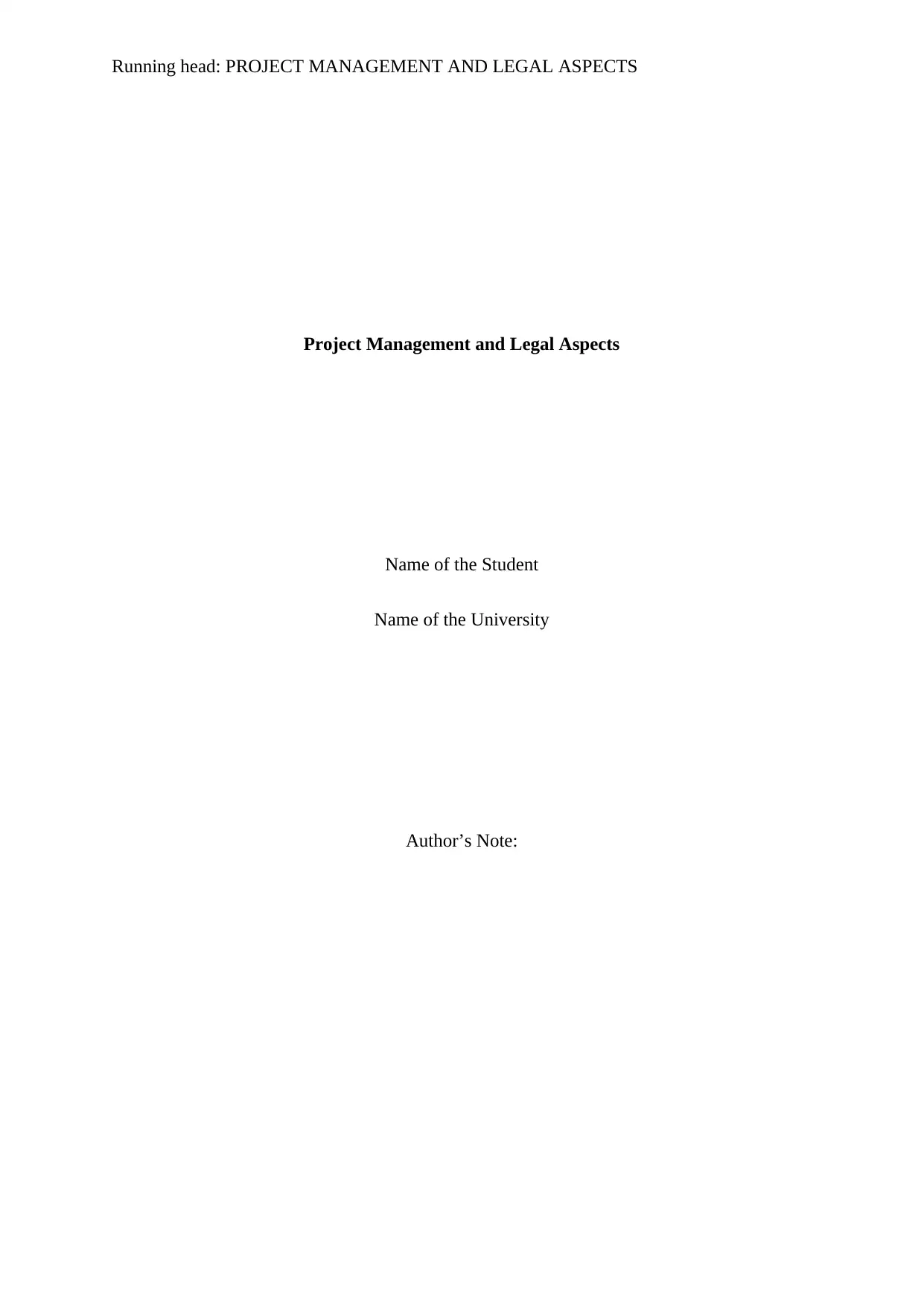
Running head: PROJECT MANAGEMENT AND LEGAL ASPECTS
Project Management and Legal Aspects
Name of the Student
Name of the University
Author’s Note:
Project Management and Legal Aspects
Name of the Student
Name of the University
Author’s Note:
Paraphrase This Document
Need a fresh take? Get an instant paraphrase of this document with our AI Paraphraser

1
PROJECT MANAGEMENT AND LEGAL ASPECTS
Table of Contents
Question 1..................................................................................................................................2
Question 2..................................................................................................................................3
Question 3..................................................................................................................................5
References..................................................................................................................................6
PROJECT MANAGEMENT AND LEGAL ASPECTS
Table of Contents
Question 1..................................................................................................................................2
Question 2..................................................................................................................................3
Question 3..................................................................................................................................5
References..................................................................................................................................6
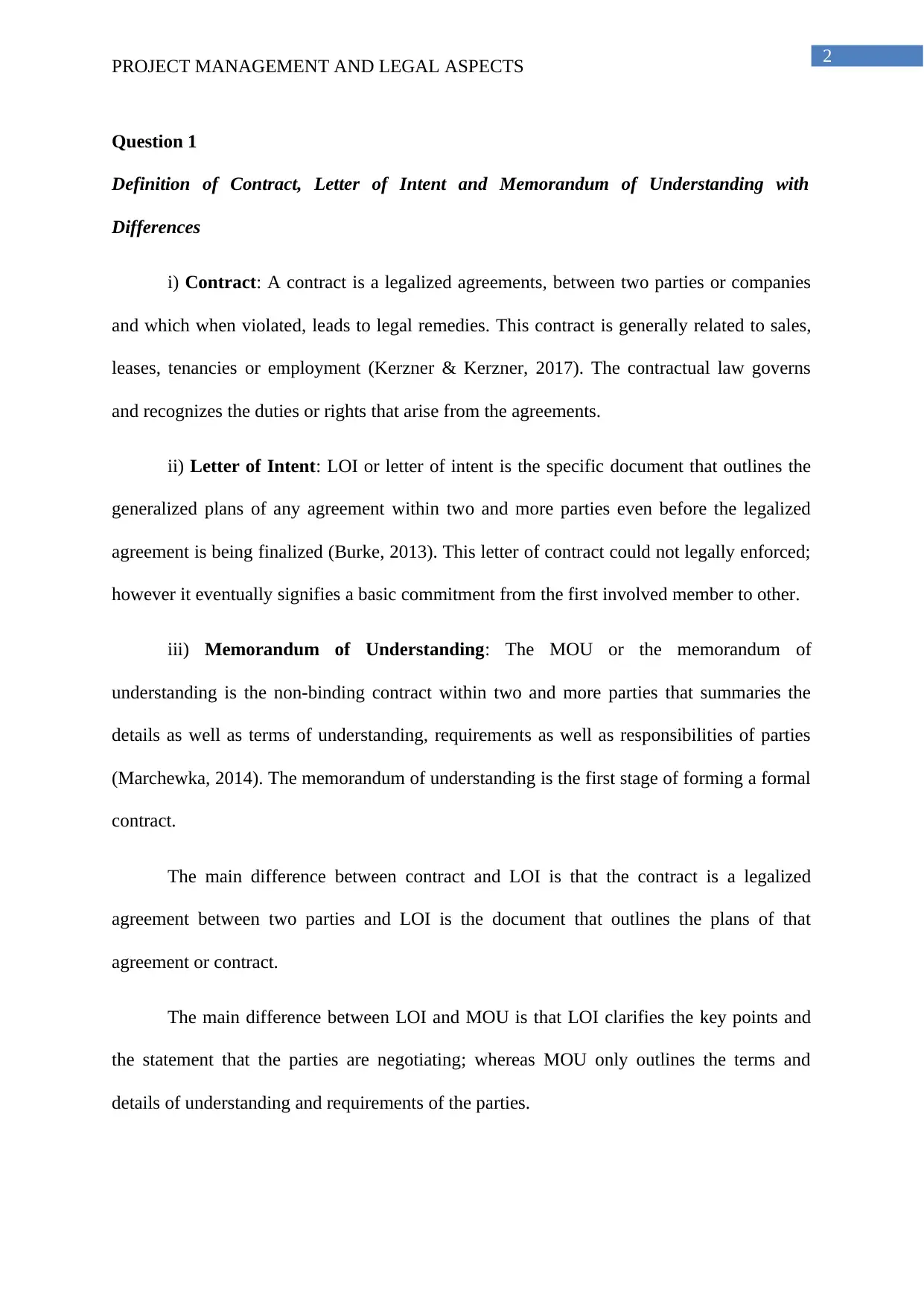
2
PROJECT MANAGEMENT AND LEGAL ASPECTS
Question 1
Definition of Contract, Letter of Intent and Memorandum of Understanding with
Differences
i) Contract: A contract is a legalized agreements, between two parties or companies
and which when violated, leads to legal remedies. This contract is generally related to sales,
leases, tenancies or employment (Kerzner & Kerzner, 2017). The contractual law governs
and recognizes the duties or rights that arise from the agreements.
ii) Letter of Intent: LOI or letter of intent is the specific document that outlines the
generalized plans of any agreement within two and more parties even before the legalized
agreement is being finalized (Burke, 2013). This letter of contract could not legally enforced;
however it eventually signifies a basic commitment from the first involved member to other.
iii) Memorandum of Understanding: The MOU or the memorandum of
understanding is the non-binding contract within two and more parties that summaries the
details as well as terms of understanding, requirements as well as responsibilities of parties
(Marchewka, 2014). The memorandum of understanding is the first stage of forming a formal
contract.
The main difference between contract and LOI is that the contract is a legalized
agreement between two parties and LOI is the document that outlines the plans of that
agreement or contract.
The main difference between LOI and MOU is that LOI clarifies the key points and
the statement that the parties are negotiating; whereas MOU only outlines the terms and
details of understanding and requirements of the parties.
PROJECT MANAGEMENT AND LEGAL ASPECTS
Question 1
Definition of Contract, Letter of Intent and Memorandum of Understanding with
Differences
i) Contract: A contract is a legalized agreements, between two parties or companies
and which when violated, leads to legal remedies. This contract is generally related to sales,
leases, tenancies or employment (Kerzner & Kerzner, 2017). The contractual law governs
and recognizes the duties or rights that arise from the agreements.
ii) Letter of Intent: LOI or letter of intent is the specific document that outlines the
generalized plans of any agreement within two and more parties even before the legalized
agreement is being finalized (Burke, 2013). This letter of contract could not legally enforced;
however it eventually signifies a basic commitment from the first involved member to other.
iii) Memorandum of Understanding: The MOU or the memorandum of
understanding is the non-binding contract within two and more parties that summaries the
details as well as terms of understanding, requirements as well as responsibilities of parties
(Marchewka, 2014). The memorandum of understanding is the first stage of forming a formal
contract.
The main difference between contract and LOI is that the contract is a legalized
agreement between two parties and LOI is the document that outlines the plans of that
agreement or contract.
The main difference between LOI and MOU is that LOI clarifies the key points and
the statement that the parties are negotiating; whereas MOU only outlines the terms and
details of understanding and requirements of the parties.
⊘ This is a preview!⊘
Do you want full access?
Subscribe today to unlock all pages.

Trusted by 1+ million students worldwide
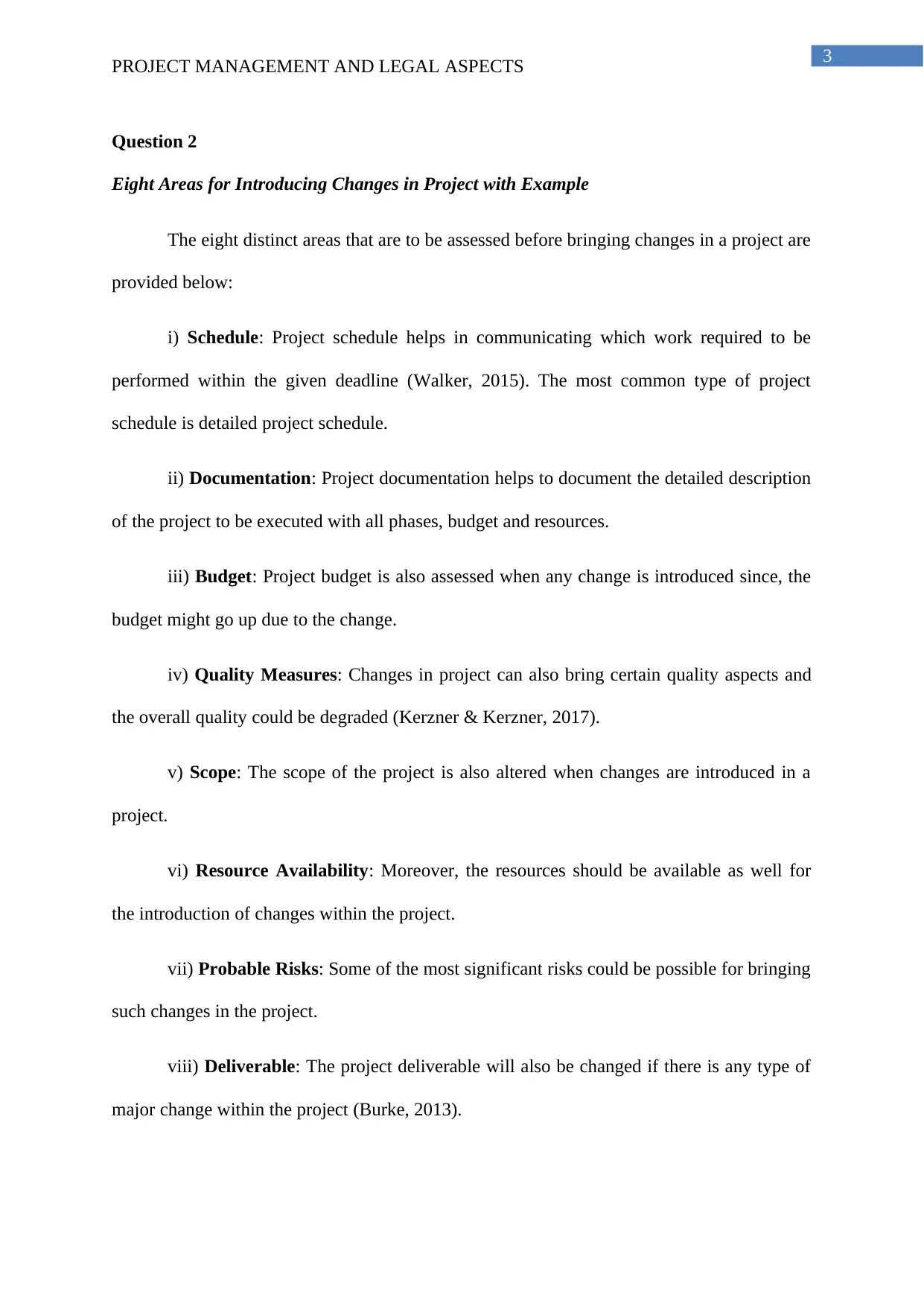
3
PROJECT MANAGEMENT AND LEGAL ASPECTS
Question 2
Eight Areas for Introducing Changes in Project with Example
The eight distinct areas that are to be assessed before bringing changes in a project are
provided below:
i) Schedule: Project schedule helps in communicating which work required to be
performed within the given deadline (Walker, 2015). The most common type of project
schedule is detailed project schedule.
ii) Documentation: Project documentation helps to document the detailed description
of the project to be executed with all phases, budget and resources.
iii) Budget: Project budget is also assessed when any change is introduced since, the
budget might go up due to the change.
iv) Quality Measures: Changes in project can also bring certain quality aspects and
the overall quality could be degraded (Kerzner & Kerzner, 2017).
v) Scope: The scope of the project is also altered when changes are introduced in a
project.
vi) Resource Availability: Moreover, the resources should be available as well for
the introduction of changes within the project.
vii) Probable Risks: Some of the most significant risks could be possible for bringing
such changes in the project.
viii) Deliverable: The project deliverable will also be changed if there is any type of
major change within the project (Burke, 2013).
PROJECT MANAGEMENT AND LEGAL ASPECTS
Question 2
Eight Areas for Introducing Changes in Project with Example
The eight distinct areas that are to be assessed before bringing changes in a project are
provided below:
i) Schedule: Project schedule helps in communicating which work required to be
performed within the given deadline (Walker, 2015). The most common type of project
schedule is detailed project schedule.
ii) Documentation: Project documentation helps to document the detailed description
of the project to be executed with all phases, budget and resources.
iii) Budget: Project budget is also assessed when any change is introduced since, the
budget might go up due to the change.
iv) Quality Measures: Changes in project can also bring certain quality aspects and
the overall quality could be degraded (Kerzner & Kerzner, 2017).
v) Scope: The scope of the project is also altered when changes are introduced in a
project.
vi) Resource Availability: Moreover, the resources should be available as well for
the introduction of changes within the project.
vii) Probable Risks: Some of the most significant risks could be possible for bringing
such changes in the project.
viii) Deliverable: The project deliverable will also be changed if there is any type of
major change within the project (Burke, 2013).
Paraphrase This Document
Need a fresh take? Get an instant paraphrase of this document with our AI Paraphraser

4
PROJECT MANAGEMENT AND LEGAL ASPECTS
The example of project change would be that if the client wants to change the product
in the last stages of project execution, there is a high chance that the project scope, budget,
deliverable, resource availability, documentation, schedule, probable risks and quality
measures would be affected. These issues could even make the project a major failure.
PROJECT MANAGEMENT AND LEGAL ASPECTS
The example of project change would be that if the client wants to change the product
in the last stages of project execution, there is a high chance that the project scope, budget,
deliverable, resource availability, documentation, schedule, probable risks and quality
measures would be affected. These issues could even make the project a major failure.
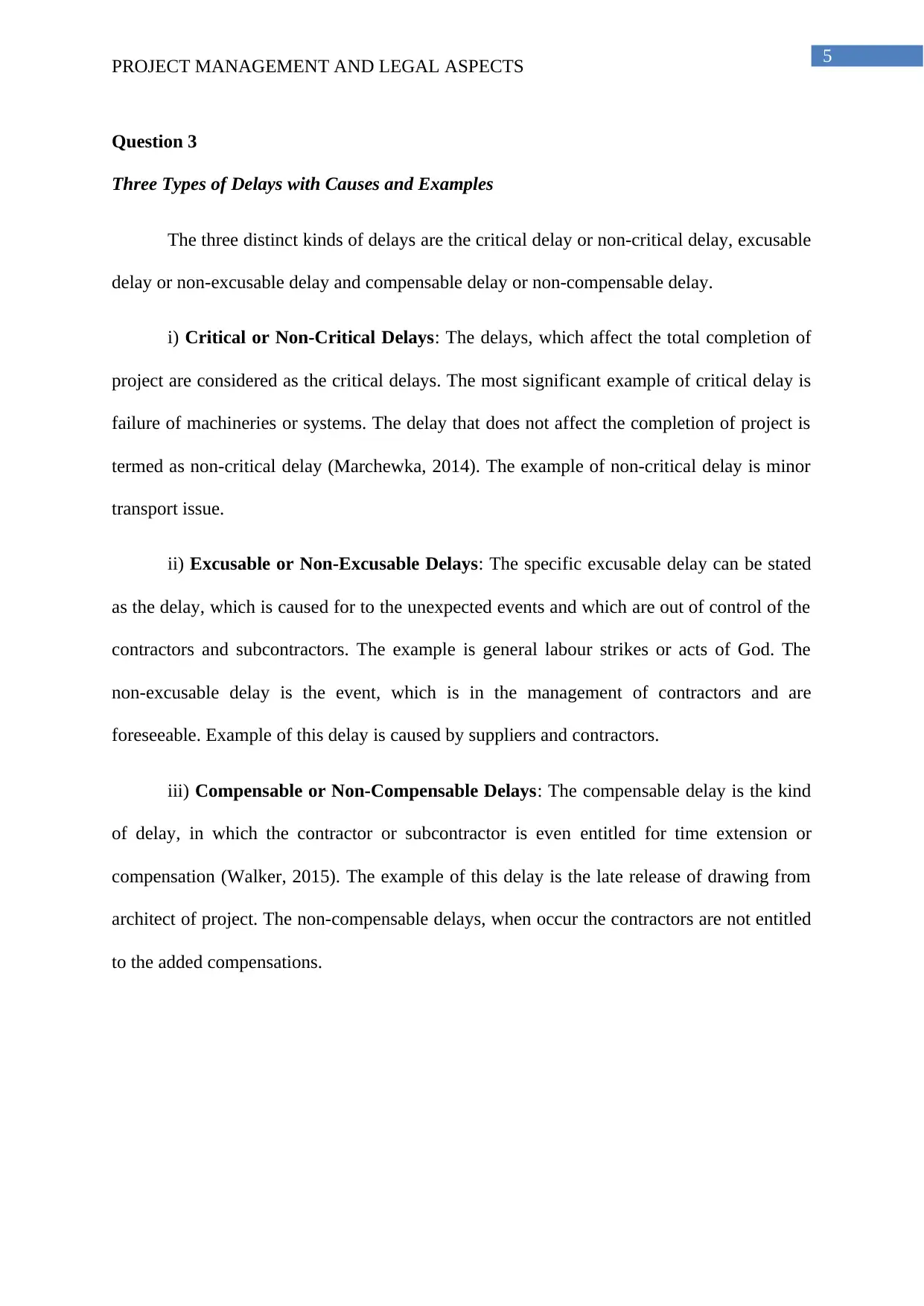
5
PROJECT MANAGEMENT AND LEGAL ASPECTS
Question 3
Three Types of Delays with Causes and Examples
The three distinct kinds of delays are the critical delay or non-critical delay, excusable
delay or non-excusable delay and compensable delay or non-compensable delay.
i) Critical or Non-Critical Delays: The delays, which affect the total completion of
project are considered as the critical delays. The most significant example of critical delay is
failure of machineries or systems. The delay that does not affect the completion of project is
termed as non-critical delay (Marchewka, 2014). The example of non-critical delay is minor
transport issue.
ii) Excusable or Non-Excusable Delays: The specific excusable delay can be stated
as the delay, which is caused for to the unexpected events and which are out of control of the
contractors and subcontractors. The example is general labour strikes or acts of God. The
non-excusable delay is the event, which is in the management of contractors and are
foreseeable. Example of this delay is caused by suppliers and contractors.
iii) Compensable or Non-Compensable Delays: The compensable delay is the kind
of delay, in which the contractor or subcontractor is even entitled for time extension or
compensation (Walker, 2015). The example of this delay is the late release of drawing from
architect of project. The non-compensable delays, when occur the contractors are not entitled
to the added compensations.
PROJECT MANAGEMENT AND LEGAL ASPECTS
Question 3
Three Types of Delays with Causes and Examples
The three distinct kinds of delays are the critical delay or non-critical delay, excusable
delay or non-excusable delay and compensable delay or non-compensable delay.
i) Critical or Non-Critical Delays: The delays, which affect the total completion of
project are considered as the critical delays. The most significant example of critical delay is
failure of machineries or systems. The delay that does not affect the completion of project is
termed as non-critical delay (Marchewka, 2014). The example of non-critical delay is minor
transport issue.
ii) Excusable or Non-Excusable Delays: The specific excusable delay can be stated
as the delay, which is caused for to the unexpected events and which are out of control of the
contractors and subcontractors. The example is general labour strikes or acts of God. The
non-excusable delay is the event, which is in the management of contractors and are
foreseeable. Example of this delay is caused by suppliers and contractors.
iii) Compensable or Non-Compensable Delays: The compensable delay is the kind
of delay, in which the contractor or subcontractor is even entitled for time extension or
compensation (Walker, 2015). The example of this delay is the late release of drawing from
architect of project. The non-compensable delays, when occur the contractors are not entitled
to the added compensations.
⊘ This is a preview!⊘
Do you want full access?
Subscribe today to unlock all pages.

Trusted by 1+ million students worldwide
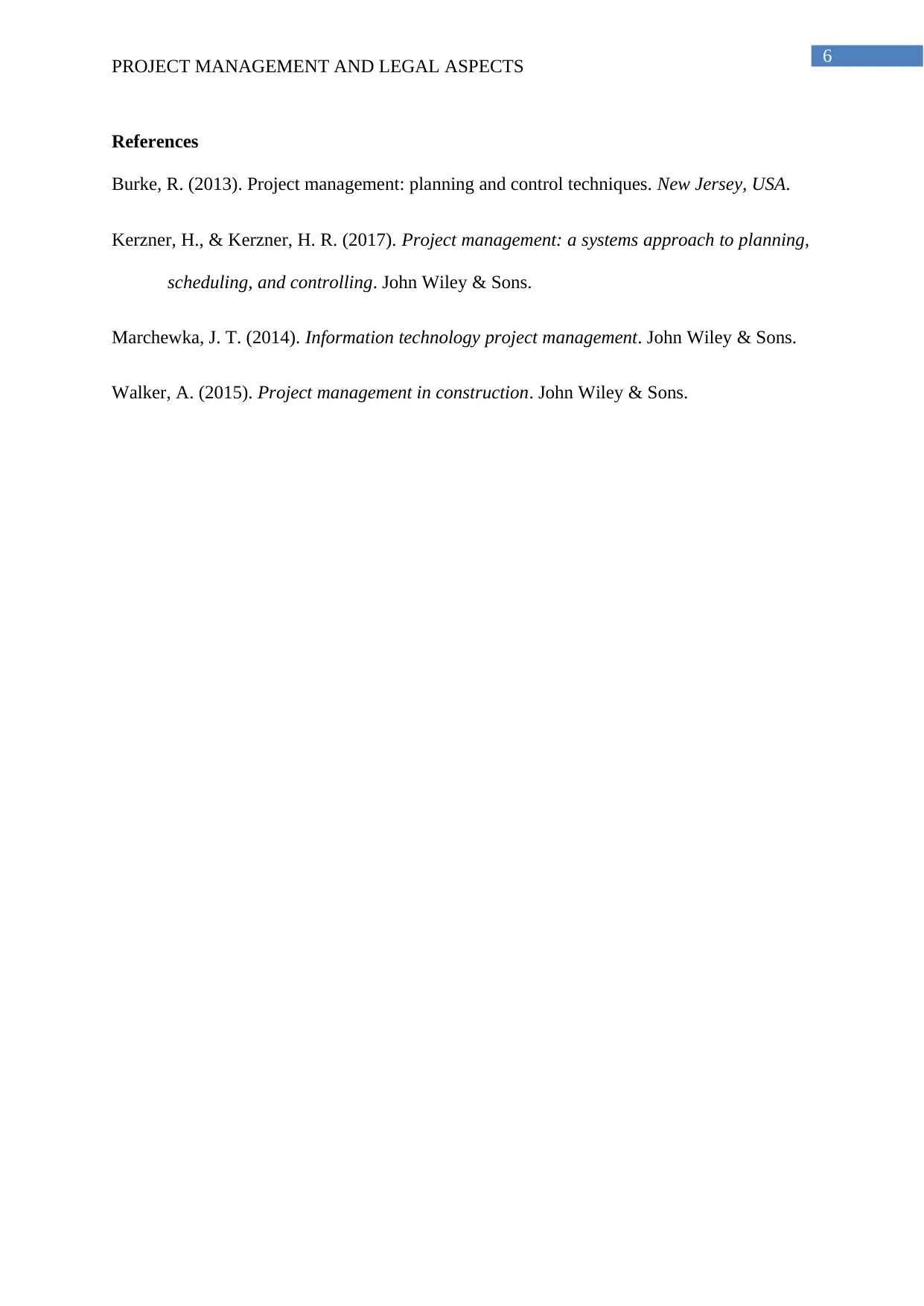
6
PROJECT MANAGEMENT AND LEGAL ASPECTS
References
Burke, R. (2013). Project management: planning and control techniques. New Jersey, USA.
Kerzner, H., & Kerzner, H. R. (2017). Project management: a systems approach to planning,
scheduling, and controlling. John Wiley & Sons.
Marchewka, J. T. (2014). Information technology project management. John Wiley & Sons.
Walker, A. (2015). Project management in construction. John Wiley & Sons.
PROJECT MANAGEMENT AND LEGAL ASPECTS
References
Burke, R. (2013). Project management: planning and control techniques. New Jersey, USA.
Kerzner, H., & Kerzner, H. R. (2017). Project management: a systems approach to planning,
scheduling, and controlling. John Wiley & Sons.
Marchewka, J. T. (2014). Information technology project management. John Wiley & Sons.
Walker, A. (2015). Project management in construction. John Wiley & Sons.
1 out of 7
Related Documents
Your All-in-One AI-Powered Toolkit for Academic Success.
+13062052269
info@desklib.com
Available 24*7 on WhatsApp / Email
![[object Object]](/_next/static/media/star-bottom.7253800d.svg)
Unlock your academic potential
© 2024 | Zucol Services PVT LTD | All rights reserved.



